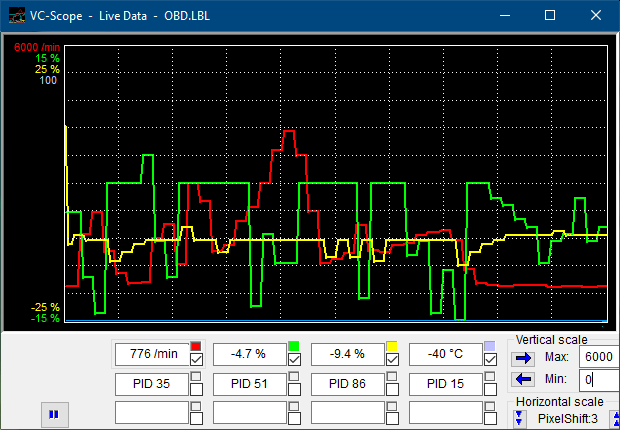- Home
- Products
- VCDS
- Support
- Online Demo / Manual
- Generic OBD-II Screen
Simulation will only work if you have JavaScript enabled
Corresponds to 1551/1552 Address Word 33 or "OBD" on a VAS 5051/5052
Generic OBD-II functionality. Because many of VW's recent factory repair manuals no longer have traditional 01-Engine "On Board Diagnostic" information and have replaced it with "Generic Scan Tool" data, this has become much more important than it was in the past. Click the "Mode" buttons in the screen-shot above for an interactive demo.
Each Generic OBD-II mode is defined by SAE J1979 - the specification paper is available from: http://www.sae.org Below is a brief overview of what each Mode does, refer to a Factory Repair Manual for specific information and testing steps.
| Mode | Meaning |
| 1 | Read Data allows you to view real-time emissions-related sensor and status data reported by the ECU. The sample rate can be sped up considerably by using the [Turbo] button and by checking No wait for 2nd controller. Since Generic OBD-2 can request the same information from both the Engine and Auto Trans, it may cause unneccessary delay for Engine readings if you aren't concerned about data from the Auto Trans. |
| 1-01 | Readiness shows the status of each of the emissions systems monitored by the ECU. |
| 2 | Freeze Frame shows the conditions present when an emissions-related fault last occurred. |
| 3 | Current DTCs shows the present emissions-related fault(s). VCDS gives you a checkbox to convert the code description into VW/Audi-specific ones. |
| 4 | Clear DTCs erases both Current and Pending DTCs. It does not repair the condition that caused them. It will reset Readiness as well, meaning the ECU will have to test monitored systems again before the corresponding bits read "Pass". |
| 5 | O2 Sensors shows the data associated with each O2 sensor, chosen from a drop-down menu. |
| 6 | Non cont. tests will run a pre-defined set of tests for various emissions-related components, for example O2 sensor aging tests. |
| 7 | Pending DTCs are fault codes that have been identified by the ECU but are deemed not yet critical enough to trigger the MIL. |
| 9 | Vehicle Info can store information including the VIN, calibration versions, and tracking information. The quantity of info varies wildly between cars. |
| 10 | Permanent DTCs are faults that cannot be erased with a scan tool, only by the ECU itself when it has tested and confirmed that the problem has been repaired. |
VC-Scope is able to graph generic OBD-2 Mode 1 data:.

Generic OBD-II functionality is "Supported" only on VW, Audi, Seat, and Skoda cars. It will likely work on many other brands of cars. We'd be happy to receive feedback as to what other brands and models of cars it does and does not work on, however, we do not feel obligated to make it work on other manufacturer's cars.
Generic OBD-II functionality is limited to cars using ISO 9141-2 ("CARB"), ISO 14230 ("KWP-2000") and ISO-15765 ("CAN") protocols. None of our interfaces support the SAE J1850-VPW and J1850-PWM protocols used by most US-market pre-2008 GM and Ford products, so VCDS cannot work at all on those cars. Most early (1996-2000) OBD-II compatible Chrysler cars used the compatible ISO-9141-2 while many 2001-2007 Chrysler cars use the incompatible SAE-J1850 standard. Most European and Asian cars use ISO or CAN and should be compatible. Generic OBD-II compatibility was required as of model year 1996 in the USA, model year 1998 in Canada, and 2001 (gasoline) or 2004 (diesel) for in the European Market. All 2008 and newer vehicles sold in the US are required to use CAN-Bus diagnostics for Generic OBD-II so it shouldn't hurt to try this function on any brand.
Interfaces: Our HEX-NET, HEX-V2, and HEX+CAN interfaces support ISO 9141-2 ("CARB"), ISO 14230 ("KWP-2000") and ISO-15765 ("CAN") protocols. Our non-CAN HEX-, KEY-, and KII- series interfaces support ISO 9141-2 ("CARB"), ISO 14230 ("KWP-2000"), but do not support ISO-15765 ("CAN"). Our Micro-CAN interface support ISO-15765 ("CAN"), but do not support ISO 9141-2 ("CARB") or ISO 14230 ("KWP-2000") for generic OBD-II. The ISO-15765 ("CAN") protocol was introduced in a few cars in model year 2004 and became universally required in all cars sold in the US market for model year 2008.
Please see the FAQ entry: What's the difference between VCDS and an OBD-II Scan-Tool?
Unless otherwise noted, all content on this site is Copyright (c) 2000-2021 by Ross-Tech LLC. All rights reserved.
"VCDS", "VCDS-Mobile" and "HEX-NET" are Registered Trademarks of Ross-Tech, LLC.
Ross-Tech is not affiliated with the Volkswagen Group in any way.


